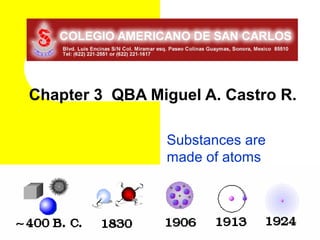
SUBSTANCES ARE MADE OF ATOMS
- 1. Chapter 3 QBA Miguel A. Castro R. Substances are made of atoms
- 2. Natural Philosophy Heraclitus versus Parmenides Heraclitus– everything is in the process of change Parmenides – Change is impossible
- 3. Natural Philosophy In400 BCE, Democritus stated, All matter consists of tiny particles called átomos, which are not created and cannot be destroyed. This was the beginning of the atomism.
- 4. Natural Philosophy The fight wasn’t over. Plato disagreed. He thought that the beauty of the world had to be caused by more than mere atoms. He proposed a system of changing elements; water, fire, earth, air.
- 5. Natural Philosophy Aristotle disagreed with both Democritus and Plato. He proposed a system called Hylomorphism. Hylomorphism is a system of ever changing states of matter.
- 6. Natural Philosophy Atomism was lost until the 16th Century Though it was still not a hard science, it was part of a belief system called alchemy. Thankfully, Robert Boyle put an end to the mess when he wrote The Skeptical Chemyst.
- 7. “Nature works by means of bodies unseen.” Lucretius
- 8. The Elements
- 10. Atomic Theory Threelaws provide supporting evidence of atoms. – Law of Definite Proportions – Law of Conservation of Mass – Law of Multiple Proportions
- 11. Law of Definite Proportions Every compound is composed of specific elements and whole- number ratios of those elements. Water H20 - 2 Hydrogen: 1 Oxygen
- 12. Law of Conservation of Mass Matter cannot be create or destroyed by normal physical or chemical processes i.e.- What goes in, must come out!
- 14. Law of Multiple Proportions The same elements can bond in differing whole-number ratios to form different compounds. Methanol CH3O Ethanol C2H5O
- 16. Dalton’s Atomic Theory Itcontained five principles based on current knowledge of atoms. We have summarized those principles in the following statements:
- 17. Dalton’s Atomic Theory 1. All matter is made up of tiny indestructible particles called atoms. 2. All atoms of one type (element) have the same mass and properties. 3. Atoms of different types (elements) have different masses and properties.
- 18. Dalton’s Atomic Theory 4. In Chemical reactions, atoms rearrange, but are not changed, created, or destroyed. 5. When different elements combine, they do so in some ratio of whole numbers.
- 19. Chapter 3 Structure of Atoms
- 20. Atomic dessert In 1897 J.J. Thomson was able to control light in a vacuum through the use of magnets. He concluded that the charge of the beam was negative. He also new that the charge was due to movement of something inside atoms He concluded that atoms contain subatomic particles with + and - charges.
- 22. Atomic Dessert He created the “plum pudding” model of the atom The Atom was a big positive charge, with very small particles of negative charges embedded in it.
- 24. Radioactive Man In1907, Ernest Rutherford performed “The Gold Foil Experiment”
- 25. Radioactive Man Conclusion: Atoms have a hard, positively charged center called a nucleus. The center was packed with tiny particles called PROTONS. Most of the atom is empty space, while the tiny, tiny electrons float around outside.
- 28. Subatomic Particles ATOM ATOM NUCLEUS NUCLEUS ELECTRONS ELECTRONS PROTONS PROTONS NEUTRONS NEUTRONS NNEGATIVE CHARGE E G A T IV E C H A R G E P O S IT IV E POSITIVE NEUTRAL NEUTRAL CHARG E CHARGE CHARG E CHARGE Atomic Number equal in a equals the # of... neutral atom
- 29. Elephants and Fleas Today, we believe that the atom has three subatomic parts: PROTON – positive charge in the nucleus NEUTRON – no charge in the nucleus ELECTRON – negative charge, orbiting the nucleus
- 30. Elephants and Fleas Atomic Number – number of protons Atomic Mass – number of protons + number of neutrons Whyaren’t electrons added into the mass of the atom?
- 31. Isotopes ISOTOPE - atoms of the same element that have a different number of neutrons This happens rather frequently, that is why the atomic mass on the periodic table is not a whole number. It is an average of the different isotopes for that element.
- 32. Chapter 3 Electron Configurations
- 33. The not so great “greats” Dalton, Thomson, and Rutherford were great men of science, but they had yet to understand the atom. It wasn’t until Niels Bohr began to think about Hydrogen that were started to understand how complex an atom really is.
- 36. Bohr: What is it good for?! Bohr, using a technique called Line Emission Spectrums, saw that electron didn’t just fly randomly around the nucleus. In fact, they are in distinct orbits called ENERGY LEVELS.
- 38. Bohr: What is it good for?! Ifyou put energy into an electron, it will change energy level into an EXCITED STATE. It will eventually drop back down to it’s GROUND STATE and give off energy in the form of light.
- 40. The colors of chemistry Electromagnetic Spectrum – radiation moving at the speed of light ranging from low-energy radio waves to high- energy cosmic rays; includes visible light It is often referred to as “light” The spectrum is created by the “jumping” of electrons between orbits
- 41. Visible Spectrum The more energy a wave has, the higher the frequency Red has the lowest frequency, therefore it has the lowest energy The most energetic color is violet ROY G BIV
- 42. Electrons are wavicles. Bohr model of the atom shows electrons orbiting a nucleus. – Electrons are particles When we attempt to observe an electron, it changes position – Electrons are waves
- 43. De Broglie to the rescue In 1924, Louis De Broglie suggested that electrons do not travel in perfect orbits, but rather in orbitals. The resulting image was an “electron cloud.”
- 45. Electron Configuration Rules Takenotes on Hog Hilton and work on board.
